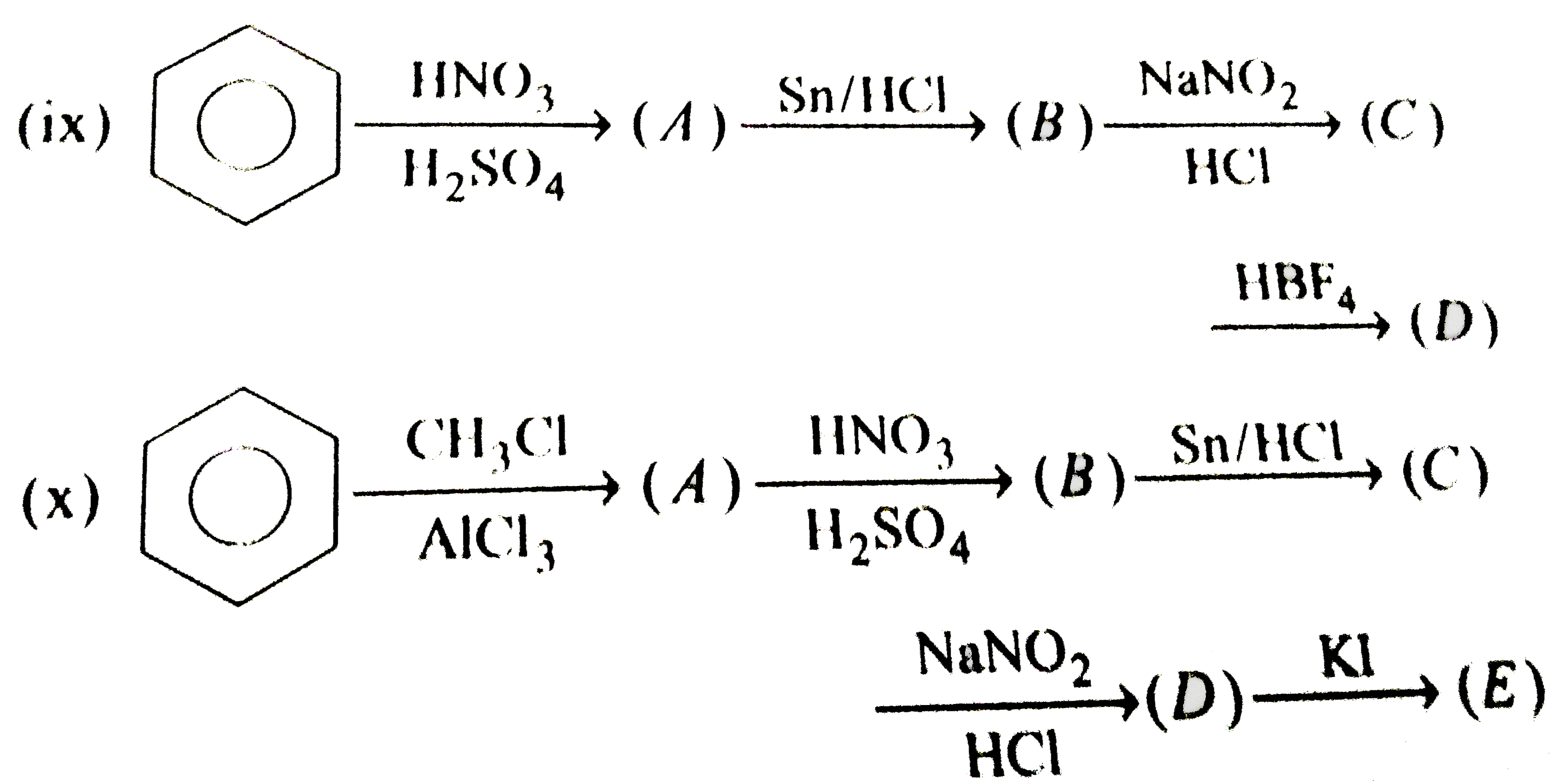C3H6NBS−−→AHBr/Peroxide−−−−−−−→BNa/ether−−−−→CAKCND−−−
To solve the problem step by step, we will identify the products from A to E based on the given reactions.
Step 1: Identify the starting compound
The starting compound is C₃H₆, which can be represented as CH₂=CH-CH₃ (propene).
Step 2: Reaction with NBS (N-bromosuccinimide)
When propene reacts with NBS, it generates an allylic bromide. The reaction primarily occurs at the allylic position, leading to the formation of allylic bromide.
Product A: The product formed is CH₂Br-CH=CH₂ (3-bromopropene).
Step 3: Reaction with HBr in the presence of peroxide
In the presence of peroxide, HBr follows the anti-Markovnikov rule. Therefore, the bromine will add to the carbon with more hydrogen atoms.
Product B: The product formed is CH₃-CHBr-CH₂ (2-bromopropane).
Step 4: Reaction with Sodium in ether
When 2-bromopropane reacts with sodium in dry ether, it undergoes a Wurtz reaction, leading to the formation of a cyclopropane.
Product C: The product formed is cyclopropane.
Step 5: Reaction with KCN
Next, we react the product A (CH₂Br-CH=CH₂) with KCN. The cyanide ion (CN⁻) acts as a nucleophile and performs a nucleophilic substitution, replacing the bromine atom.
Product D: The product formed is CH₂-CH=CH-CN (3-cyanopropene).
Step 6: Hydrolysis of Product D
The cyanide group can be hydrolyzed to form a carboxylic acid. The hydrolysis of the nitrile (C≡N) will yield a carboxylic acid.
Product E: The product formed is CH₂-CH=CH-COOH (3-carboxypropanoic acid).
Step 7: Oxidative cleavage
Finally, the carboxylic acid can undergo oxidative cleavage, resulting in the formation of malonic acid.
Final Product E: The final product is malonic acid (HOOC-CH₂-COOH).
Summary of Products:
- A: CH₂Br-CH=CH₂ (3-bromopropene)
- B: CH₃-CHBr-CH₂ (2-bromopropane)
- C: Cyclopropane
- D: CH₂-CH=CH-CN (3-cyanopropene)
- E: Malonic acid (HOOC-CH₂-COOH)
The starting compound is C₃H₆, which can be represented as CH₂=CH-CH₃ (propene).
When propene reacts with NBS, it generates an allylic bromide. The reaction primarily occurs at the allylic position, leading to the formation of allylic bromide.
In the presence of peroxide, HBr follows the anti-Markovnikov rule. Therefore, the bromine will add to the carbon with more hydrogen atoms.
When 2-bromopropane reacts with sodium in dry ether, it undergoes a Wurtz reaction, leading to the formation of a cyclopropane.
Next, we react the product A (CH₂Br-CH=CH₂) with KCN. The cyanide ion (CN⁻) acts as a nucleophile and performs a nucleophilic substitution, replacing the bromine atom.
The cyanide group can be hydrolyzed to form a carboxylic acid. The hydrolysis of the nitrile (C≡N) will yield a carboxylic acid.
Finally, the carboxylic acid can undergo oxidative cleavage, resulting in the formation of malonic acid.
- A: CH₂Br-CH=CH₂ (3-bromopropene)
- B: CH₃-CHBr-CH₂ (2-bromopropane)
- C: Cyclopropane
- D: CH₂-CH=CH-CN (3-cyanopropene)
- E: Malonic acid (HOOC-CH₂-COOH)
Similar Questions
Complete the following by providing (A),(B),(C) and (D) :
(i)CH3CH2CH2OHPBr−−→(A)alc.KOH−−−−−−→Δ
(B)HBr−−→(C)NH3−−→(D)
(ii)CH3CH2CH2Ialc.KOH−−−−−−→Δ(A)H+/H2O−−−−−→
(B)SOCI2−−−→(C)H−−−−−−→LiAIH4(D)
(iii)CH3CHBrCH3alc.KOH−−−−−−→Δ(A)HBr−−−−−−−→Peroxide
(B)Nal−−−−−−→Acetone(C)H−−−−−→Ether
(iv)CH3CH2CH=CH2NBS−−−−−→Light(A)alc.KOH−−−−−−→Δ(B)
HBr−−→(C)
(v)CH3CH2MgBrCH3CHO/H2O−−−−−−−−−→(A)HBr−−→(B)
alc.KOH−−−−−−→Δ(C)
(A)NH3−−→(B)CHCI3+KOH(alc.)−−−−−−−−−−−−−→(C)Na−−−−−−−→C2H5OH
CH3−C∣CH3H−NHCH3

(viii)CH3CH2Br(i)(CH2)6N4−−−−−−−−−−−→(ii)H2O/H+(A)NaOH−−−→(B)
(i)O3−−−−−−−−−−−→(ii)Zn/HOH(A)+(C)conc.NaOH−−−−−−−→(D)

View SolutionWrite A,B and C in the given reactions :
(i)C6H5N2CICuCN−−−→AH2O/H+−−−−−→BNH3−−→C
(ii) CH3CH2BrKCN−−→ALiA1H40−−−−→BHNO2−−−→0∘CC
(iii) C6H5NO2Fe/HCI−−−−→AHNO2−−−→273KBH2O/H+−−−−−→2ΔC
(iv) CH3COOH2NH3−−→ΔANaOBr−−−→BNaNO2/HCI−−−−−−−−→C
(v) CH3CH2INaCN−−−→AOH−−−−−−−−−−→partial hydrolysisBNaOH/Br2−−−−−−→C.
View Solution
Knowledge Check
CH3C∣BrHCH3alc./KOH−−−−−−→AHBr//peroxide−−−−−−−−→BCH3Na−−−−→C
In the above reaction sequence, the final product is:Adiethyl etherB1-methoxypropaneCisopropyl alcoholDpropylene glycolCH3C∣BrHCH3alc./KOH−−−−−−→AHBr//peroxide−−−−−−−−→BCH3Na−−−−→C
In the above reaction sequence, the final product is:Adiethyl etherB1-methoxypropaneCisopropyl alcoholDpropylene glycolCH3CH2OHP+I2−−−→AMg Ether BHCHO−−−→CH2O−−→D The product 'D' is:-
AButanalBn - butyl alcoholCn - propyl alcoholDIsopropyl alcohol
CH3−CH2−BrAlco. KOH−−−−−→ΔBHBr−−→CNa/ether−−−−−→D
The compound D is:
View SolutionIn the reaction :
CH3−Br∣CH−CH3alcKOH−−−−→AHBr−−−−→PeroxideBCH3ONa−−−−−→C,C is __________
View SolutionCH3CH2OHP+I2−−−→AMg−−→etherBHCHO−−−→CH2O−−→D
The product 'D' is-
View SolutionC2H5OHNa−−→AC2H5I−−−→B ,where B is :
View SolutionThe product (D ) in the following sequence of reaction is
CH3COOHNH3−−→(A) Heat −−−−→(B)
P2O5−−→(C)Na+C2H5OH−−−−−−−−→(D)
View Solution
